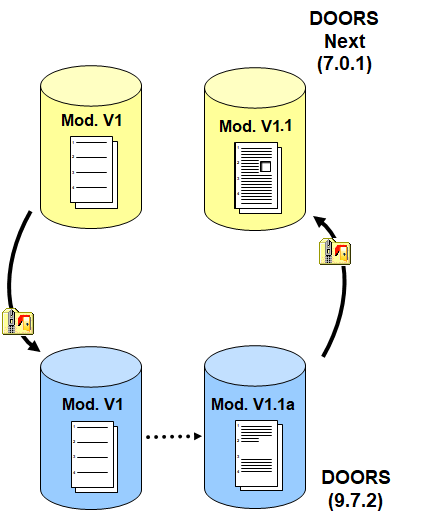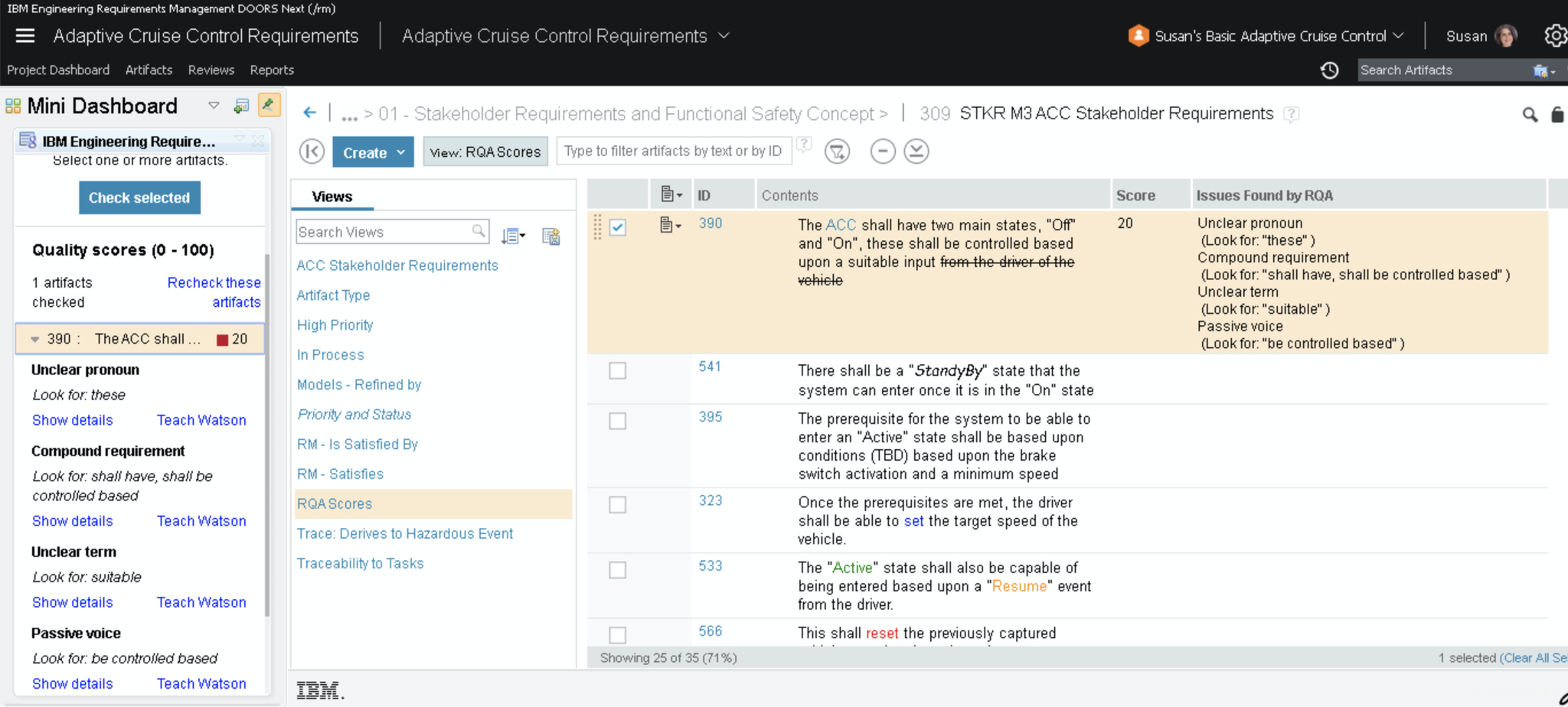Question & Answer
Question
What is the IBM Rational DOORS Kit for ISO 26262 and IEC 61508?
Answer
The Rational DOORS Kit for ISO 26262 and IEC 61508 is part of the Rational DOORS 9.4, 9.4.0.1, 9.5, 9.5.1, 9.5.2, 9.6, and 9.6.1 release. Project teams in safety-critical industries, such as the automotive industry, can use the kit to help lower the risks and costs of complying with functional safety standards.
You can download the kit as part of the Rational DOORS product download from IBM Passport Advantage. In addition, you can find information about the IBM Rational Rhapsody Kit for ISO 26262 and IEC 61508 in the Rational Rhapsody online product documentation in IBM Knowledge Center. The Rational Rhapsody and the Rational DOORS kits help to quickly and safely deploy the IBM Rational Solution for Automotive.
Kit contents
| Title | Description |
| TÜV SÜD “Fit for Purpose” certificate for IBM Rational DOORS for ISO 26262 and IEC 61508 | This PDF document indicates that the TÜV SÜD has certified that Rational DOORS is fit for purpose for developing safety-related software according to IEC 61508 and/or ISO 26262, up to SIL 3 or ASIL D. The certificate covers Rational DOORS 9.4, 9.4.0.1, 9.5, 9.5.1, 9.5.2, 9.6, and 9.6.1. |
| TÜV SÜD Report to the Certificate for ISO 26262 and IEC 61508 | This document is the report for the TÜV SÜD Certificate for Rational DOORS for ISO 26262 and IEC 61508. |
| IBM Rational DOORS Safety Manual | This PDF document describes the features of Rational DOORS, as considered by the TÜV SÜD certificate. The document also describes the workflow and checks that project teams can use for safety-critical development. |
| IBM Rational DOORS ISO 26262 template | This template of a Rational DOORS project can be used as a starting point or example of how to configure Rational DOORS for use on safety-critical projects. The template is in DOORS project archive (.dpa) format. |
| ISO 26262 DOORS template read me | This PDF document describes the contents of the template and explains how to use and deploy it. |
| IBM Rational DOORS Intended Use Validation Test Suite | This test suite can be used to help qualify Rational DOORS in safety-critical projects. The test suite is provided as a DOORS project archive file (.dpa). |
| Intended Use Validation Test Suite Overview | This PDF document describes the Intended Use Validation Test Suite. The document also explains how to use or augment the test suite to qualify the use of Rational DOORS in a specific environment. |
Benefits of using the kit
TÜV SÜD certificates to support tool qualification
The TÜV SÜD Certificate and Report to the Certificate provide an independent third-party review of the Rational DOORS development processes, customer support and defect processes, internal validation test suites, and the Rational DOORS Safety Manual. An organization can use the certificate and report to provide justification and evidence to qualify to use specific tools. The next table contains information about how the certificate and report can support tool qualification.
| ISO tool qualification method | Applicability of the TÜV SÜD certificate and related assets |
| 1a: Increased confidence from use in accordance with 11.4.7 | The TÜV SÜD evaluated the customer information and bug tracking of IBM Rational software, which contributes to an increased confidence because it helps with systematically collecting data and acquiring errors over a large number of customers and projects. This is only one part of the argument and needs to be extended by you based on your usage of Rational DOORS. |
| 1b: Evaluation of the tool development process in accordance with 11.4.8 | The TÜV SÜD evaluated the Rational DOORS development process according to an appropriate standard based on the relevant portions of the ISO 26262:2011 standard. In addition, IBM holds an ISO 9001 certificate for the Rational DOORS development process. Therefore, the TÜV SÜD certificate and the ISO 9001 certification can be used as justification for this tool qualification method. |
| 1c: Validation of the software tool in accordance with 11.4.9 | The TÜV SÜD analyzed the validation suite that IBM uses for Rational DOORS relative to the usage of features that are described in the Rational DOORS Safety Manual. Each organization must ensure that the described conditions of use and the used features match the descriptions in the safety manual. Any features that are not described in the safety manual are not covered by the certificate and need extra measures, such as manual validation. In addition, IBM provides a Rational DOORS Intended Use Validation Test Suite for customers who want to use Rational DOORS differently than is described in the safety manual to validate that the features work as intended in their environment. This test suite is not covered by the certificate, but the test suite can be used to help enforce the argument for 1c. |
| 1d: Development in accordance with a safety standard | This argument is not applicable because Rational DOORS was not developed as a safety item in accordance with a safety standard. The methods that the ISO 26262 requires, such as MC/DC coverage and semiformal verification, are not completely applied. |
Validation test suite to run validation tests in specific environments
The Rational DOORS Intended Use Validation Test Suite is a customizable Rational DOORS project that contains a set of requirements that trace to features, test cases, and tests. You can run the tests in your environment to document and verify your usage of Rational DOORS.
Rational DOORS ISO 26262 template
The ISO 26262 template includes the basic modules and attributes that you can use to capture requirements and safety information throughout the safety lifecycle. The template also includes DXL scripts that determine the Automotive Safety Integrity Level (ASIL) of a safety goal based on severity, exposure, controllability, and the propagation of the ASIL down the requirements hierarchy from the safety goals.
Additional resources
For more information about using Rational DOORS for projects that must comply with ISO 26262, see the white paper ISO 26262 compliant usages of IBM Rational DOORS in safety critical E/E-projects within the automotive domain (ftp://public.dhe.ibm.com/common/ssi/ecm/en/ral14048usen/RAL14048USEN.PDF).
For specific guidance about requirements and safety management, along with tool mentors that can help with ISO 26262 compliance, use the practice content and workflow template for IBM Rational Method Composer and IBM Rational Team Concert™. If you have a Rational Method Composer license, you can download the additional practice content at http://ibm.com/support/docview.wss?uid=swg24030663.
Disclaimer
The artifacts described here, including the practice mappings to standards, such as DO-178B and ISO-26262, can be used to help Licensee meet compliance obligations, which may be based on laws, regulations, standards or additional practices. Any directions, suggested usage, or guidance provided by the practice mapping does not constitute legal, accounting, or other professional advice, and Licensee is cautioned to obtain its own legal or other expert counsel. Licensee is solely responsible for ensuring that Licensee and Licensee’s activities, applications and systems comply with all applicable laws, regulations, standards and practices. Use of this practice mapping does not guarantee compliance with any law, regulation, standard or additional practice.




